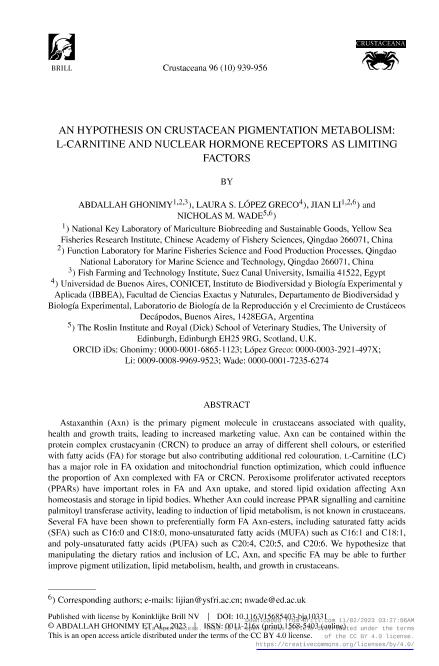Artículo
An hypothesis on crustacean pigmentation metabolism: L-carnitine and nuclear hormone receptors as limiting factors
Fecha de publicación:
11/2023
Editorial:
Brill Academic Publishers
Revista:
Crustaceana
ISSN:
0011-216X
Idioma:
Inglés
Tipo de recurso:
Artículo publicado
Clasificación temática:
Resumen
Astaxanthin (Axn) is the primary pigment molecule in crustaceans associated with quality, health and growth traits, leading to increased marketing value. Axn can be contained within the protein complex crustacyanin (CRCN) to produce an array of different shell colours, or esterified with fatty acids (FA) for storage but also contributing additional red colouration. l-Carnitine (LC) has a major role in FA oxidation and mitochondrial function optimization, which could influence the proportion of Axn complexed with FA or CRCN. Peroxisome proliferator activated receptors (PPARs) have important roles in FA and Axn uptake, and stored lipid oxidation affecting Axn homeostasis and storage in lipid bodies. Whether Axn could increase PPAR signalling and carnitine palmitoyl transferase activity, leading to induction of lipid metabolism, is not known in crustaceans. Several FA have been shown to preferentially form FA Axn-esters, including saturated fatty acids (SFA) such as C16:0 and C18:0, mono-unsaturated fatty acids (MUFA) such as C16:1 and C18:1, and poly-unsaturated fatty acids (PUFA) such as C20:4, C20:5, and C20:6. We hypothesize that manipulating the dietary ratios and inclusion of LC, Axn, and specific FA may be able to further improve pigment utilization, lipid metabolism, health, and growth in crustaceans.
Palabras clave:
ASTAXANTHIN
,
ASTAXANTHIN ESTER
,
CARNITINE
,
CRUSTACYANIN
,
LONG CHAIN FATTY ACID
,
PPAR
Archivos asociados
Licencia
Identificadores
Colecciones
Articulos(IBBEA)
Articulos de INSTITUTO DE BIODIVERSIDAD Y BIOLOGIA EXPERIMENTAL Y APLICADA
Articulos de INSTITUTO DE BIODIVERSIDAD Y BIOLOGIA EXPERIMENTAL Y APLICADA
Citación
Ghonimy, Abdallah; Lopez, Laura Susana; Li, Jian; Wade, Nicholas M.; An hypothesis on crustacean pigmentation metabolism: L-carnitine and nuclear hormone receptors as limiting factors; Brill Academic Publishers; Crustaceana; 96; 10; 11-2023; 939-956
Compartir
Altmétricas




